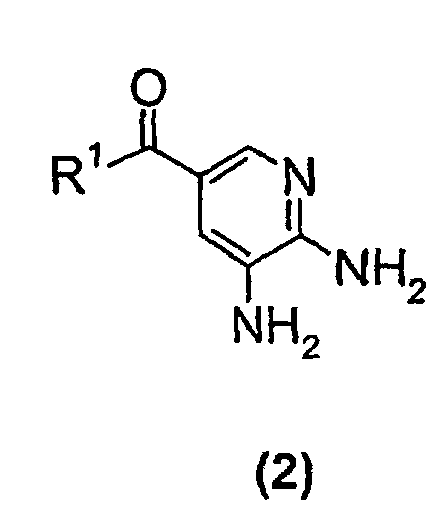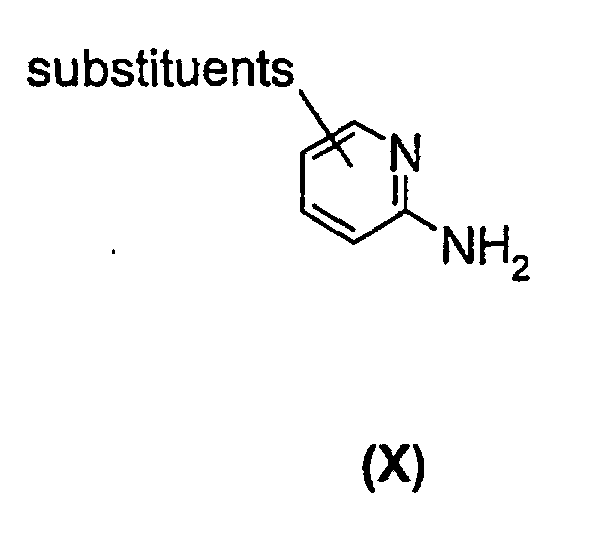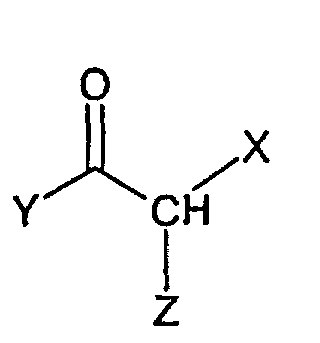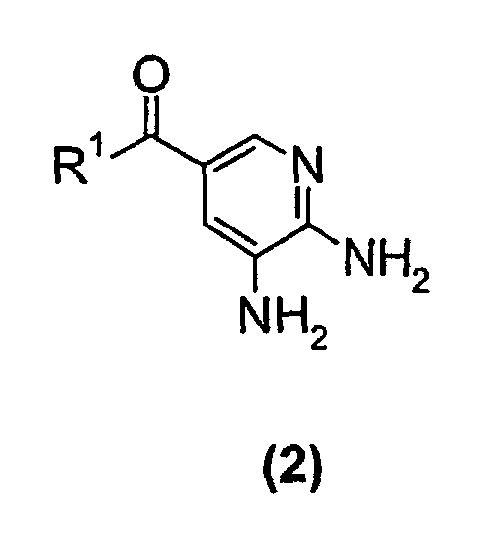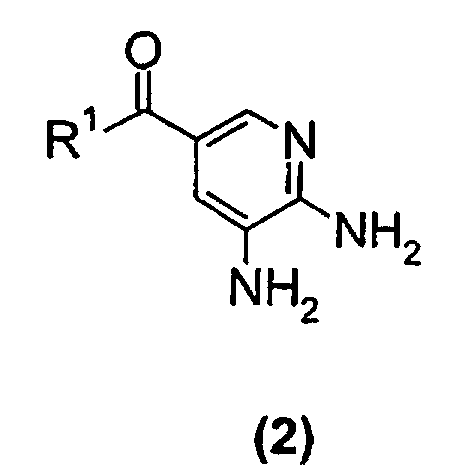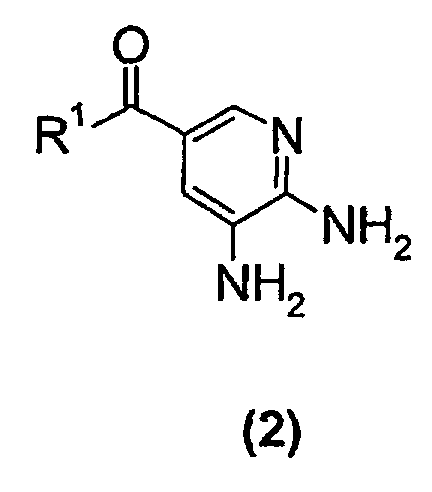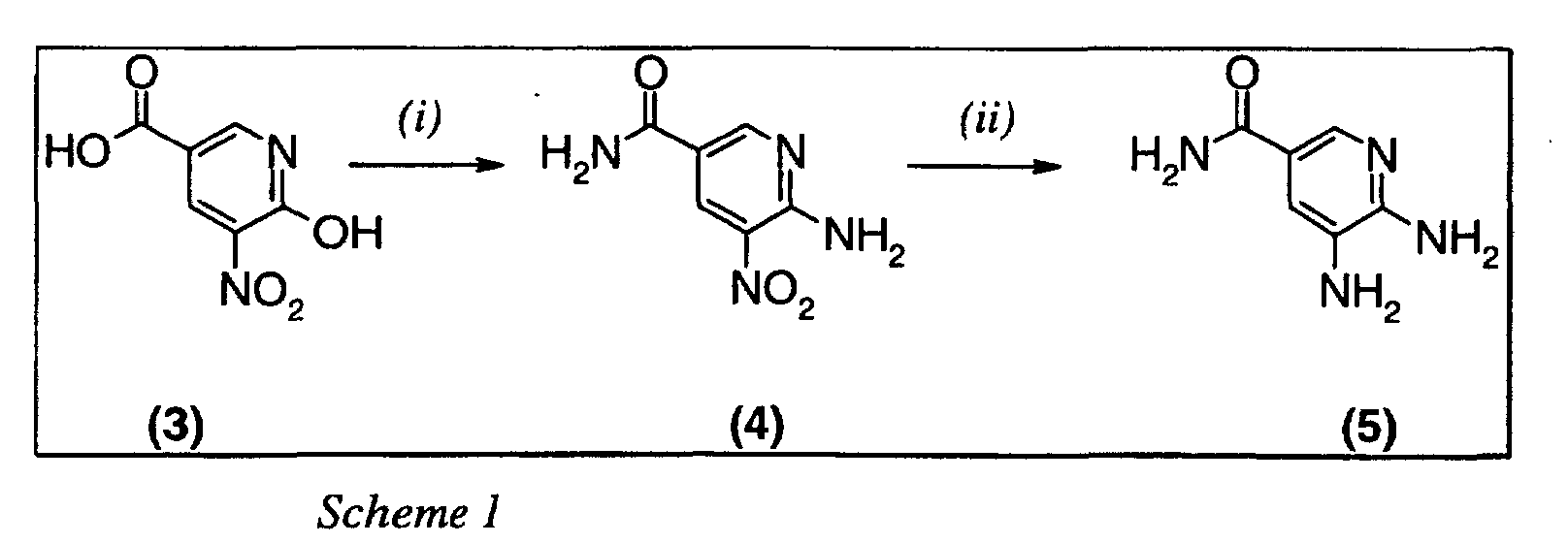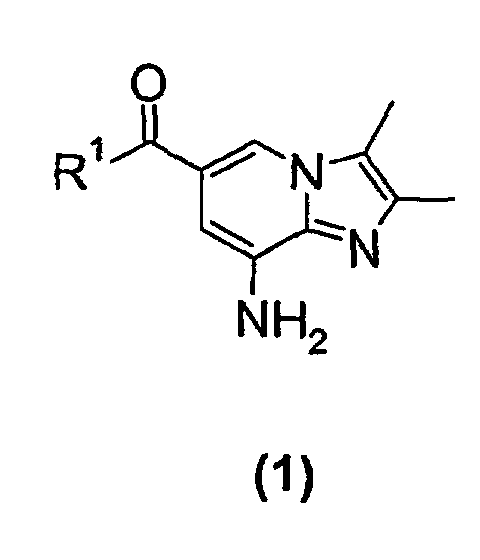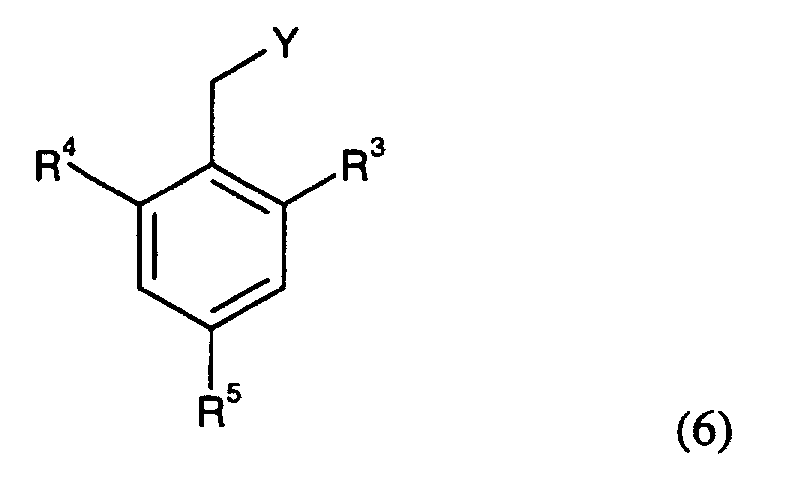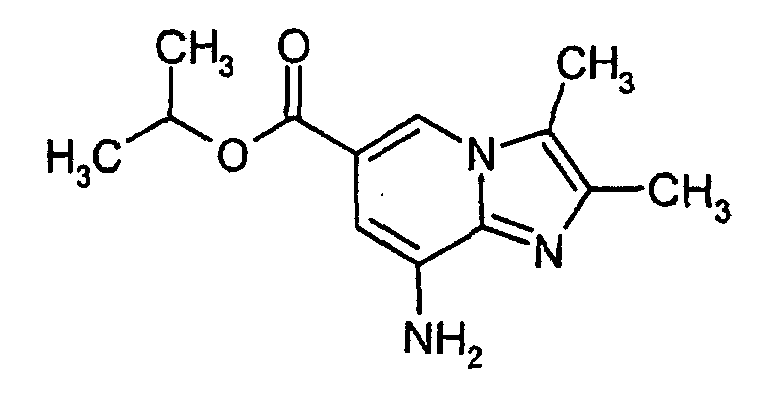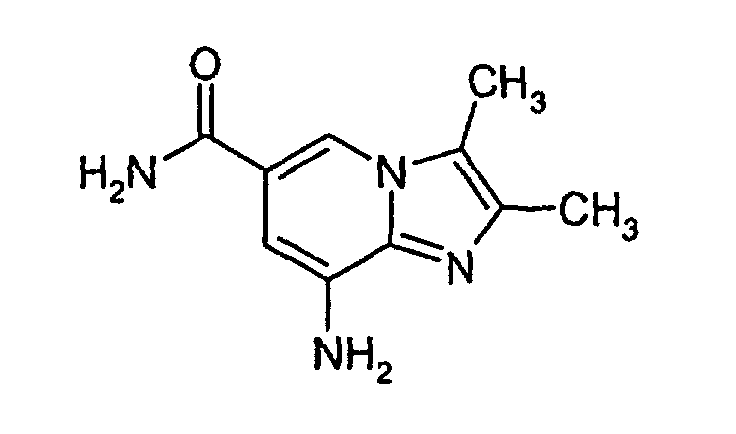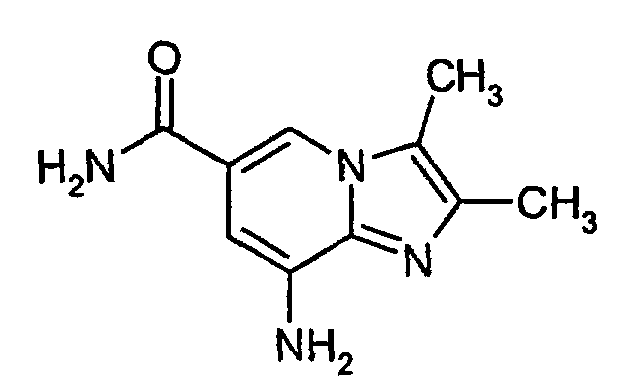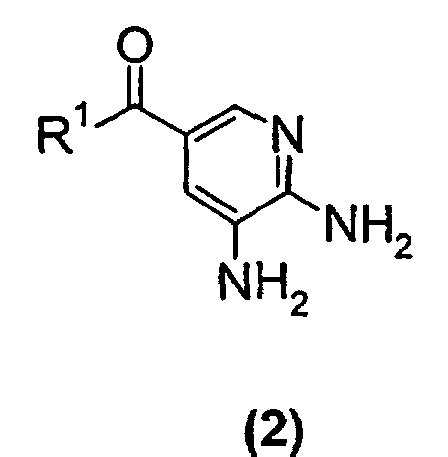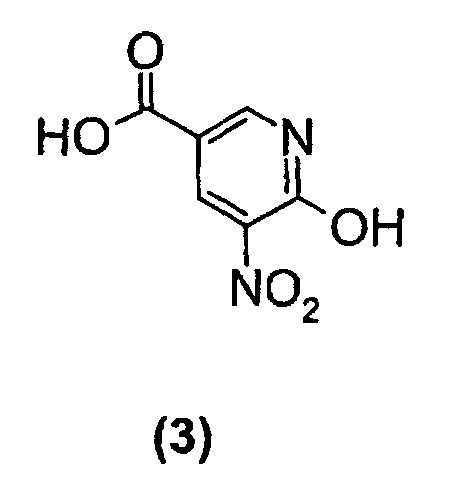EP1317455B9 - Process for preparing a substituted imidazopyridine compound - Google Patents
Process for preparing a substituted imidazopyridine compound Download PDFInfo
- Publication number
- EP1317455B9 EP1317455B9 EP01963665A EP01963665A EP1317455B9 EP 1317455 B9 EP1317455 B9 EP 1317455B9 EP 01963665 A EP01963665 A EP 01963665A EP 01963665 A EP01963665 A EP 01963665A EP 1317455 B9 EP1317455 B9 EP 1317455B9
- Authority
- EP
- European Patent Office
- Prior art keywords
- compound
- formula
- added
- butanone
- process according
- Prior art date
- Legal status (The legal status is an assumption and is not a legal conclusion. Google has not performed a legal analysis and makes no representation as to the accuracy of the status listed.)
- Expired - Lifetime
Links
- 0 *C(c(cc1N)cnc1N)=O Chemical compound *C(c(cc1N)cnc1N)=O 0.000 description 4
- RJUBUKNWPYQPPJ-UHFFFAOYSA-N CC(C)OC(c(cc1N)c[n]2c1nc(C)c2C)=O Chemical compound CC(C)OC(c(cc1N)c[n]2c1nc(C)c2C)=O RJUBUKNWPYQPPJ-UHFFFAOYSA-N 0.000 description 1
Classifications
-
- C—CHEMISTRY; METALLURGY
- C07—ORGANIC CHEMISTRY
- C07D—HETEROCYCLIC COMPOUNDS
- C07D471/00—Heterocyclic compounds containing nitrogen atoms as the only ring hetero atoms in the condensed system, at least one ring being a six-membered ring with one nitrogen atom, not provided for by groups C07D451/00 - C07D463/00
- C07D471/02—Heterocyclic compounds containing nitrogen atoms as the only ring hetero atoms in the condensed system, at least one ring being a six-membered ring with one nitrogen atom, not provided for by groups C07D451/00 - C07D463/00 in which the condensed system contains two hetero rings
- C07D471/04—Ortho-condensed systems
Definitions
- the present invention relates to a new process for the preparation of a substituted imidazopyridine compound, more specifically a new process for the preparation of a 2,3-dimethylimidazo[1,2-a]pyridine substituted in the 6-position by a carboxamido or a carboxyalkyl group.
- the present invention also relates to new intermediates used in the process.
- the present invention relates to a new process suitable for large-scale preparation of a substituted imidazopyridine compound of formula (1), wherein R 1 is a C 1 -C 6 alkoxy or NH 2 group, comprising the step of reacting a compound of the formula (2) wherein R 1 is a C 1 -C 6 alkoxy or NH 2 group, with a 3-halo-2-butanone compound in cyclohexanone.
- the reaction is carried out in an inert solvent, such as acetone, alcohols, benzene, N,N-dimethylformamide, tetrahydrofurane, chloroform, or diethyl ether, preferably at elevated temperature, and optionally in the presence of an inorganic or organic base.
- an inert solvent such as acetone, alcohols, benzene, N,N-dimethylformamide, tetrahydrofurane, chloroform, or diethyl ether
- the reaction is characterized by long reaction times, e.g. 16 to 84 hours, high reaction temperatures and relatively low yields, e.g. 22% to 55%.
- the reaction is thereby not suitable for large-scale preparation of substituted imidazopyridine compounds.
- the present invention provides a new process for large-scale preparation of substituted imidazopyridine compound of formula (1) wherein R 1 is a C 1 -C 6 alkoxy or NH 2 group, comprising the step of reacting a compound of the formula (2) with a 3-halo-2-butanone compound in cyclohexanone.
- a compound of the formula (2) wherein R 1 is a C 1 -C 6 alkoxy group is reacted with a 3-halo-2-butanone compound in cyclohexanone to give a compound of the formula (1) wherein R 1 is a C 1 -C 6 alkoxy group.
- a compound of the formula (2) wherein R 1 is a NH 2 group is reacted with a 3-halo-2-butanone compound in cyclohexanone to give a compound of the formula (1) wherein R 1 is NH 2 group.
- the process of the present invention is performed by solving or suspending a compound of formula (2) wherein R 1 is a C 1 -C 6 alkoxy or NH 2 group, in cyclohexanone and adding a 3-halo-2-butanone compound, heat the reaction for a few hours and thereafter isolate a compound of formula (1) wherein R 1 is a C 1 -C 6 alkoxy or NH 2 group, in high yields.
- cyclohexanone is not crucial for carrying out the present invention, and can therefore in practical circumstances be adjusted according to needs and equipment used. It is also possible to mix cyclohexanone with inert solvents, such as ethers.
- suitable inert solvents comprises, but is not limited to, to tetrahydrofuran (THF).
- THF tetrahydrofuran
- the amount of inert solvent can be up to around 50%, by volume, without causing a decrease in yield.
- 3-halo-2-butanone compound is not critical for carrying out the present invention. It is for practical and economical reasons preferred to add 1.1 to 5 molar equivalents, preferably 1.1 to 2 equivalents.
- suitable 3-halo-2-butanone compounds comprises, but is not limited to, 3-bromo-2-butanone and 3-chloro-2-butanone, of which the latter is preferred.
- Reaction temperatures and reaction times can be varied to meet the actual need. It is preferred to have a reaction temperature from 80°C to 100°C. This reaction temperature gives a complete reaction within a few hours, e.g. 1 to 4 hours. Conversion is usually above 95% and the isolated yield is usually above 70%.
- the starting material to be used in the present invention can be prepared as disclosed in WO 99/55706 or alternatively as is described below in Scheme 1.
- Compound (3) in Scheme 1 is treated with thionyl chloride, or any equivalent reagent, at elevated temperature in an appropriate solvent for a few hours to give the corresponding chloride compound.
- the reaction is performed using around 1 to 5 equivalents thionyl chloride, preferably 1 to 2.5 equivalents, in toluene at approximately 100°C for 2 to 8 hours.
- the corresponding chloride compound is thereafter treated with 2 to 25 equivalents ammonia, preferably 3 to 12 equivalents, in the same solvent as above at approximately ambient temperature to give compound (4).
- Compound (4) in Scheme 1 is hydrogenated in an aqueous alcoholic solution using a catalyst to give compound (5).
- suitable catalyst comprises, but is not limited, to palladium, ruthenium or mixtures thereof.
- Pd-Ru/C paste is the preferred catalyst.
- alcohols comprises, but is not limited to, methanol, ethanol and propanol, of which methanol is preferred.
- the substituted imidazopyridine compound of formula (1), wherein R 1 is a C 1 -C 6 alkoxy or NH 2 group, prepared according to the present invention can thereafter be used to prepare certain substituted imidazopyridine derivatives that are particularly effective as inhibitors of the gastrointestinal H + , K + -ATPase and thereby as inhibitors of gastric acid secretion.
- the base is e.g. an alkali metal hydroxide, such as sodium hydroxide and potassium hydroxide, an alkali metal carbonate, such as potassium carbonate and sodium carbonate; or an organic amine, such as triethylamine.
- R 6 and R 7 may together with the nitrogen atom to which they are attached, form a saturated or unsaturated ring optionally containing one or more further heteroatoms thereby forming e.g. morpholine, piperazine, pyrrolidine, or piperidine.
- the reaction can be carried out by heating the reactants in the neat amino compound or dissolved in an inert solvent under standard conditions.
- Methyl 8-amino-2,3-dimethylimidazo[1,2-a]pyridine-6-carboxylate (0.8 g, 3.6 mmol), 2,6-dimethylbenzylchloride (0.57 g, 3.7 mmol), sodium carbonate (1.0 g, 9.4 mmol) and a catalytic amount of potassium iodide were added to acetonitrile (10 ml) and were refluxed for 20 h. Following filtration, the salts were washed with methylene chloride and the solvents were evaporated under reduced pressure. The residue was purified by column chromatography on silica gel using methylene chloride: ethyl acetate (75:25) as eluent. The yellow residue was treated with hexane to give 0.23 g (19%) of the title product.
- Ethyl 8-amino-2,3-dimethylimidazo[1,2-a]pyridine-6-carboxylate (0.7 g, 3.0 mmol), 2-ethyl-6-methylbenzylchloride (0.5 g, 3.0 mmol), sodium carbonate (0.64 g, 6.0 mmol) and a catalytic amount of potassium iodide were added to acetone (50 ml) and were refluxed for 20 h. Following filtration, the acetone was evaporated under reduced pressure to give an oil. The oily product was purified by column chromatography on silica gel using diethyl ether : petroleum ether (1:1) as eluent to give 0.12 g (9%) of the title product.
- Ethyl 2,3-dimethyl-8-(2-ethyl-6-methylbenzylamino)-imidazo[1,2-a]pyridine-6-carboxylate (0.12 g, 0.33 mmol)
- propylamine 1.0 g, 17 mmol
- a catalytic amount of sodium cyanide were refluxed in methanol (20 ml) for 24 h.
- An additional amount of propylamine 1.0 g, 17 mmol was added and the reaction mixture was refluxed for 24 h.
- the solvent was evaporated under reduced pressure and the residue was purified by column chromatography on silica gel using diethyl ether as eluent.
Landscapes
- Chemical & Material Sciences (AREA)
- Organic Chemistry (AREA)
- Nitrogen Condensed Heterocyclic Rings (AREA)
- Pharmaceuticals Containing Other Organic And Inorganic Compounds (AREA)
Abstract
Description
- The present invention relates to a new process for the preparation of a substituted imidazopyridine compound, more specifically a new process for the preparation of a 2,3-dimethylimidazo[1,2-a]pyridine substituted in the 6-position by a carboxamido or a carboxyalkyl group. In further aspects, the present invention also relates to new intermediates used in the process.
- The present invention relates to a new process suitable for large-scale preparation of a substituted imidazopyridine compound of formula (1), wherein R1 is a C1-C6 alkoxy or NH2 group, comprising the step of reacting a compound of the formula (2) wherein R1 is a C1-C6 alkoxy or NH2 group, with a 3-halo-2-butanone compound in cyclohexanone.
- A similar reaction is described in EP 33094, EP 204 285, EP 228 006, EP 308 917, and WO 99/55706 wherein a substituted aminopyridine compound of the general formula (X) is reacted with a compound of formula wherein X is i.a. H, CH3 or an ester group, such as COOCH3 or COOC2H5,
Y is i.a. CH3, CH2CH3, and
Z is a leaving group, such as halogen, mesyl or tosyl,
to give a compound of the general structure wherein X and Y are as described above. - The reaction is carried out in an inert solvent, such as acetone, alcohols, benzene, N,N-dimethylformamide, tetrahydrofurane, chloroform, or diethyl ether, preferably at elevated temperature, and optionally in the presence of an inorganic or organic base.
- The reaction is characterized by long reaction times, e.g. 16 to 84 hours, high reaction temperatures and relatively low yields, e.g. 22% to 55%. The reaction is thereby not suitable for large-scale preparation of substituted imidazopyridine compounds.
- We have surprisingly found that if the process of the present invention is carried out as described herein the reaction time can be shortened, the reaction temperature can be lowered and the yield is increased.
- The present invention provides a new process for large-scale preparation of substituted imidazopyridine compound of formula (1) wherein R1 is a C1-C6 alkoxy or NH2 group, comprising the step of reacting a compound of the formula (2) with a 3-halo-2-butanone compound in cyclohexanone.
In a first embodiment of the present invention a compound of the formula (2) wherein R1 is a C1-C6 alkoxy group, is reacted with a 3-halo-2-butanone compound in cyclohexanone to give a compound of the formula (1) wherein R1 is a C1-C6 alkoxy group. -
- The process of the present invention is performed by solving or suspending a compound of formula (2) wherein R1 is a C1-C6 alkoxy or NH2 group, in cyclohexanone and adding a 3-halo-2-butanone compound, heat the reaction for a few hours and thereafter isolate a compound of formula (1) wherein R1 is a C1-C6 alkoxy or NH2 group, in high yields.
- The amount of cyclohexanone is not crucial for carrying out the present invention, and can therefore in practical circumstances be adjusted according to needs and equipment used. It is also possible to mix cyclohexanone with inert solvents, such as ethers. Example of suitable inert solvents comprises, but is not limited to, to tetrahydrofuran (THF). The amount of inert solvent can be up to around 50%, by volume, without causing a decrease in yield.
- The amount of 3-halo-2-butanone compound is not critical for carrying out the present invention. It is for practical and economical reasons preferred to add 1.1 to 5 molar equivalents, preferably 1.1 to 2 equivalents. Example of suitable 3-halo-2-butanone compounds comprises, but is not limited to, 3-bromo-2-butanone and 3-chloro-2-butanone, of which the latter is preferred.
- Reaction temperatures and reaction times can be varied to meet the actual need. It is preferred to have a reaction temperature from 80°C to 100°C. This reaction temperature gives a complete reaction within a few hours, e.g. 1 to 4 hours. Conversion is usually above 95% and the isolated yield is usually above 70%.
-
- Compound (3) in Scheme 1 is treated with thionyl chloride, or any equivalent reagent, at elevated temperature in an appropriate solvent for a few hours to give the corresponding chloride compound. The reaction is performed using around 1 to 5 equivalents thionyl chloride, preferably 1 to 2.5 equivalents, in toluene at approximately 100°C for 2 to 8 hours. The corresponding chloride compound is thereafter treated with 2 to 25 equivalents ammonia, preferably 3 to 12 equivalents, in the same solvent as above at approximately ambient temperature to give compound (4).
- Compound (4) in Scheme 1 is hydrogenated in an aqueous alcoholic solution using a catalyst to give compound (5). Example of suitable catalyst comprises, but is not limited, to palladium, ruthenium or mixtures thereof. Pd-Ru/C paste is the preferred catalyst. Examples of alcohols comprises, but is not limited to, methanol, ethanol and propanol, of which methanol is preferred.
- The substituted imidazopyridine compound of formula (1), wherein R1 is a C1-C6 alkoxy or NH2 group, prepared according to the present invention can thereafter be used to prepare certain substituted imidazopyridine derivatives that are particularly effective as inhibitors of the gastrointestinal H+, K+-ATPase and thereby as inhibitors of gastric acid secretion.
- Compounds of the Formula (1) can be reacted with a compound of the Formula (6) wherein R3 is H, C1-C6 alkyl, hydroxylated C1-C6 alkyl or halogen; R4 is H, C1-C6 alkyl, hydroxylated C1-C6 alkyl or halogen; R5 is H, or halogen; and Y is a leaving group, such as a halide, tosyl or mesyl group, to give a compound of Formula (7). wherein R1, R3, R4, and R5 are as defined above. It is convenient to conduct this reaction in an inert solvent, e.g. acetone, acetonitrile, dimethoxyethane, methanol, ethanol or dimethylformamide with or without a base. The base is e.g. an alkali metal hydroxide, such as sodium hydroxide and potassium hydroxide, an alkali metal carbonate, such as potassium carbonate and sodium carbonate; or an organic amine, such as triethylamine.
- Compounds of the Formula (7) wherein R1 is C1-C6 alkoxy can thereafter be further reacted with an amino compound of the general Formula (8) wherein R6 and R7 are the same or different and chosen from a group consisting of H, C1-C6 alkyl, hydroxylated C1-C6 alkyl, C1-C6 alkoxy-substituted C1-C6 alkyl, hydroxylated C1-C6 alkoxy-substituted C1-C6 alkyl, aryl, to give the corresponding amide compound.
- R6 and R7 may together with the nitrogen atom to which they are attached, form a saturated or unsaturated ring optionally containing one or more further heteroatoms thereby forming e.g. morpholine, piperazine, pyrrolidine, or piperidine.
- The reaction can be carried out by heating the reactants in the neat amino compound or dissolved in an inert solvent under standard conditions.
-
-
- In a reactor, sodium bromide (84 kg) is suspended in dimethylformamide (125 1). 3-Chloro-2-butanone (85 kg) is added at 15°C-30°C. Stirring is continued for 4 hours and then filtered: The filtercake is washed with cyclohexanone (38 1). The bromobutanone thereby prepared is ready to be used in the cyclisation step.
-
- To a suspension of 5,6-diamino-nicotinic acid methyl ester (1 eq., 5.1 g) in cyclohexanone (50 ml) bromobutanone (1.2 equiv., 3.9 ml) was added over 10 min. The mixture was heated to 100°C (inner temperature) and stirred 2.5 h at this temperature. The mixture was cooled to room temperature and the pale solid was filtered off and was washed with TBME (3x10ml). Drying under reduced pressure at 45°C. Yield: 6.53 g (75%).
-
- To a suspension of 5,6-diamino-nicotinic acid ethyl ester (1 eq., 5.0 g) in cyclohexanone (50 ml) bromobutanone (1.4 equiv., 5.95 g) was added over 15 min. The dark brown mixture was heated to 100°C (inner temperature) and stirred 1.5 h at this temperature. The mixture was cooled to room temperature and the light brown solid was filtered off and was washed with TBME (20 ml). Drying under reduced pressure at 45°C. Yield: 5.06 g (65%).
-
- To a suspension of 5,6-diamino-nicotinic acid isopropyl ester (1 eq., 5.1 g) in cyclohexanone (50 ml) bromobutanone (1.2 equiv., 3.4 ml) was added over 10 min. The dark brown mixture was heated to 100°C (inner temperature) and stirred 1.5h at this temperature. The suspension was cooled to room temperature and the pale yellow solid was filtered off and was washed with TBME (3x10ml). Drying under reduced pressure at 45°C. Yield: 6.0 g (74%).
-
- 5,6-Diamino-nicotinamide (50 g, 0.313 mol (assay: 95.4%), 1.0 equiv.) was suspended in cyclohexanone (250 mL). The suspension was heated to 100°C. The filtrate (bromobutanone in cyclohexanone) was added at 100°C over 1 h 10 min. Heating was continued for 3 h and the heating source was thereafter removed. The reaction mixture was allowed to cool to 20°C and stirred at this temperature for another 2 h. The solid was filtered off, washed carefully with TBME (2 x 330 mL) and dried to yield 70.3 g of title compound. Yield: 70%.
-
- NaBr (27.0 g; 0.259 mol; 1.33 equiv) was suspended in cyclohexanone (220 mL) and 3-chloro-2-butanone (25.7 mL; 0.242 mol; 1.24 equiv) was added in one portion. The mixture was heated to 80°C and stirred for 3 h. The mixture was cooled to 50°C, the white solid was filtered off and washed with cyclohexanone (60 mL). 5,6-Diamino-nicotinamide (30 g; 0.1946 mol; 1.0 equiv) was added to the filtrate and the mixture was heated to 100°C for 4 h, after which 98% conversion was determined by HPLC. The reaction mixture was cooled to 20°C, stirring was continued for 2h at 20°C. The solid was filtered off, washed with TBME (220 mL) and dried to yield 46.6 g of the title compound. Yield: 73%.
-
- 5,6-Diamino-nicotinamide (30.0 g; 0.183 mol; 1.0 equiv) was suspended in cyclohexanone (280 mL). 3-Bromo-2-butanone (24 mL; 0.22 mol; 1.2 equiv) was added and the mixture was heated for 4 h to 100°C.The reaction mixture was cooled to 20°C and allowed to stir for another 2 h. The solid was filtered off, washed with TBME (200 mL) and dried to yield 48.4 g of the title compound. Yield: 78%.
-
- Methyl 8-amino-2,3-dimethylimidazo[1,2-a]pyridine-6-carboxylate (0.8 g, 3.6 mmol), 2,6-dimethylbenzylchloride (0.57 g, 3.7 mmol), sodium carbonate (1.0 g, 9.4 mmol) and a catalytic amount of potassium iodide were added to acetonitrile (10 ml) and were refluxed for 20 h. Following filtration, the salts were washed with methylene chloride and the solvents were evaporated under reduced pressure. The residue was purified by column chromatography on silica gel using methylene chloride: ethyl acetate (75:25) as eluent. The yellow residue was treated with hexane to give 0.23 g (19%) of the title product.
-
- Ethyl 8-amino-2,3-dimethylimidazo[1,2-a]pyridine-6-carboxylate (0.7 g, 3.0 mmol), 2-ethyl-6-methylbenzylchloride (0.5 g, 3.0 mmol), sodium carbonate (0.64 g, 6.0 mmol) and a catalytic amount of potassium iodide were added to acetone (50 ml) and were refluxed for 20 h. Following filtration, the acetone was evaporated under reduced pressure to give an oil. The oily product was purified by column chromatography on silica gel using diethyl ether : petroleum ether (1:1) as eluent to give 0.12 g (9%) of the title product. 1H-NMR (500 MHz, CDCl3): δ 1.25 (t, 3H), 1.5 (t, 3H), 2.35 (s, 3H), 2.42 (s, 3H), 2.44 (s, 3H), 2.75 (q, 2H), 4.45-4.5 (m, 4H), 4.9 (bs, 1H), 6.8 (s, 1H), 7.05-7.2 (m, 3H), 8.1 (s, 1H)
-
- Ethyl 2,3-dimethyl-8-(2-ethyl-6-methylbenzylamino)-imidazo[1,2-a]pyridine-6-carboxylate (0.12 g, 0.33 mmol), propylamine (1.0 g, 17 mmol) and a catalytic amount of sodium cyanide were refluxed in methanol (20 ml) for 24 h. An additional amount of propylamine (1.0 g, 17 mmol) was added and the reaction mixture was refluxed for 24 h. The solvent was evaporated under reduced pressure and the residue was purified by column chromatography on silica gel using diethyl ether as eluent. Crystallization from diethyl ether gave 0.053 g (42%) of the title compound. 1H-NMR (300 MHz, CDCl3): δ 1.0 (t, 3H), 1.2 (t, 3H), 1.65-1.75 (m, 2H), 2.3 (s, 3H), 2.35 (s, 3H), 2.38 (s, 3H), 2.7 (q, 2H), 3.4-3.5 (m, 2H), 4.35 (d, 2H), 4.9 (bs, 1H), 6.2 (bs, 1H), 6.35 (s, 1H), 7.0-7.2 (m, 4H), 7.85 (s, 1H).
-
- 8-Amino-2,3-dimethylimidazo[1,2-a]pyridine-6-carboxamide (3.3 g, 16.2 mmol), 2-ethyl-6-methylbenzylchloride (2.73 g, 16.2 mmol), potassium carbonate (8.0 g, 58 mmol) and potassium iodide (1.1 g, 6.6 mmol) were added to acetone (150 ml) and refluxed for 20 h. An additional amount of 2-ethyl-6-methylbenzylchloride (1.0 g, 5.9 mmol) was added and the reaction mixture was refluxed for 7 h. Methylene chloride (60 ml) and methanol (30 ml) were added. The reaction mixture was filtered and the solvents were evaporated under reduced pressure. The residue was purified by column chromatography on silica gel using methylene chloride: methanol (100:7) as eluent. Crystallization from ethyl acetate gave 2.8 g (50%) of the title compound. 1H-NMR (300 MHz, CDCl3): δ 1.2 (t, 3H), 2.34 (s, 3H), 2.36 (s, 3H), 2.38 (s, 3H), 2.7 (q, 2H), 4.4 (d, 2H), 4.9 (bs, 1H), 6.0 (bs, 2H), 6.45 (s, 1H), 7.0-7.2 (m, 3H), 7.9, (s, 1H).
-
- 2,3-dimethyl-8-(2-ethyl-6-methylbenzylamino)-imidazo[1,2-a]pyridine-6-carboxamide mesylate (11.0 g, 0.025 mol) and sodium hydroxide (7.0 g, 0.17 mol) were solved in ethanol (95 %) (120 ml) and was refluxed for 20 h. The solvent was evaporated under reduced pressure and to the residue was added water (150 ml). The pH was adjusted to 5 by addition of conc. HCl and acetic acid and the solid that precipitated was isolated by filtration, washed with water and acetone, and dried to give 7.6 g (88 %) of the title compound. 1H-NMR (500 MHz, DMSO-d6): δ 1.15 (t, 3H), 2.26 (s, 3H), 2.34 (s, 3H), 2.39 (s, 3H), 2.69 (q, 2H), 4.38 (d, 2H), 5.2 (bs, 1H), 6.73 (s, 1H), 7.07-7.2 (m, 3H), 8.12 (s, 1H)
-
- 2,3-Dimethyl-8-(2-ethyl-6-methylbenzylamino)-imidazo[1,2-a]pyridine-6-carboxylic acid (0.15 g, 0.44 mmol) and o-Benzotriazol-1-yl-N,N,N',N'-Tetramethyluronium tetrafluoroborate (TBTU)(0.14 g, 0.44 mmol) were added to methylene chloride (10 ml). Morpholine (0.12 g, 1.4 mmol) was added and the reaction mixture was stirred at ambient temperature for 1.5 h. The reaction mixture was added to a column with silica gel and purification by chromatography using ethyl acetate : methylene chloride (1:1) as eluent gave 0.12 g (66%) of the desired product. 1H-NMR (300 MHz, CDCl3): δ 1.2 (t, 3H), 2.32 (s, 3H), 2.35 (s, 3H), 2.37 (s, 3H), 2.7 (q, 2H), 3.7 (s, 8H), 4.35 (d, 2H), 4.95 (bs, 1H), 6.15 (s, 1H), 7.0-7.2 (m, 3H), 7.4 (s, 1H)
-
- 2,3-dimethyl-8-(2-ethyl-6-methylbenzylamino)-imidazo[1,2-a]pyridine-6-carboxylic acid (0.3 g, 0.88 mmol) and o-Benzotriazol-1-yl-N,N,N',N'-Tetramethyluronium tetrafluoroborate (TBTU)(0.29 g, 0.90 mmol) were added to methylene chloride (10 ml). 2-(2-aminoethoxy)ethanol (0.2 g, 1.9 mmol) was added and the reaction mixture was stirred at ambient temperature for 2 h. The solvent was evaporated under reduced pressure and the residue was purified by column chromatography on silica gel using methylene chloride:methanol (9:1) as eluent. Crystallization from diethyl ether gave 0.24 g (80%) of the desired product. 1H-NMR (500 MHz, CDCl3): δ 1.25 (t, 3H), 2.25 (s, 3H), 2.3 (s, 3H), 2.35 (s, 3H), 2.75 (q, 2H), 3.4-3.45 (m, 2H), 3.55-3.7 (m, 6H), 4.35 (d, 2H), 5.05 (t, 1H), 6.45 (s, 1H), 7.0-7.2 (m, 4H), 7.5 (s, 1H)
-
- Isopropyl 8-amino-2,3-dimethylimidazo[1,2-a]pyridine-6-carboxylate (9.85 kg, 1.0 equiv., 29.71 mol) was suspended in isopropanol (59 L); NaI (0.6 equiv., 2.68 kg, 17.88 mol) and K2CO3 (2.5 equiv, 10.29 kg, 74.48 mol) were added and the mixture was heated to about 70°C. 2,6-Dimethylbenzyl chloride (1.1 equiv, 5.22 kg, 32.77 mol) was dissolved in isopropanol (-60 L) and this solution was added to the reaction mixture. After the addition was complete, the temperature was kept at 60°C for additional 1.5 hours. Additional K2CO3 was added (9.15 kg) and the resulting suspension was stirred for further 2h at 60°C. Additional 2,6-dimethylbenzyl chloride (2.76 kg) in isopropanol (22L) was added slowly at an temperature of 60°C; after the addition the reaction mixture was stirred for further 4 hours at this temperature. The suspension was diluted with water (124L), cooled, stirred and filtered. The filtercake was washed with water and then with cold isopropanol, dried under reduced pressure at 40°C to give 11.37 kg wet material, yield: 90%.
-
- A reactor was charged with isopropyl 8-[(2,6-dimethylbenzyl)amino]-2,3-dimethylimidazo[1,2-a]pyridine-6-carboxylate (11.30 kg, 1 equiv., 27.02 mol) and THF (45 L), ethanolamine (18.97 kg, 11 equiv., 309.2 mol) was added at about 20°C. The suspension was heated to about 100°C. Some solvent was distilled off and then THF (35 L) was added and the distillation was continued. The procedure of adding THF and distilling it off was repeated until complete conversion. To the suspension ethanol (140L) was added and the suspension was heated to reflux. To obtain a clear solution additional ethanol (13L) was added. The hot solution was filtered and then cooled. The white solid was filtered off, washed with ethanol and dried to yield the product as a white powder. (8271 g).
- 100 g of 6-hydroxy-5-nitro-nicotinic acid (0.54 mol; HPLC > 98% area) was suspended in toluene (750 mL). DMF (1 mL, 0.013 mol, 0.024 equiv.) was added and the mixture was heated to 110°C (inner temperature). Thionylchloride (99 mL, 2.5 equiv.) was added over 120 min. Heating was continued for 4h at 110°C. The reaction mixture was concentrated to half the volume (400 mL of solvent were distilled off), and toluene (400 mL) was added. This procedure was repeated once again (410 mL of toluene were distilled off and fresh toluene (410 mL) was added again). The solution was then cooled to 20°C and slowly added to aqueous ammonia (25%, 440 mL, 12 equiv.) over 40 min. Precipitation started immediately. During the addition the temperature was maintained below 15°C. After the addition had been completed the reaction mixture was allowed to warm up to room temperature and stirring was continued for 16h. The solid was filtered off, washed with water (500 mL), ethanol (250 mL), TBME (250 mL) and dried (50-10 mbar, 40°C bath temperature, 16 h) to yield 91.3 g of the title compound (0.501 mol, 87%).
- 44.5 g of 6-amino-5-nitro-nicotinamide (0.24 mol; HPLC: 93% area) were suspended in methanol/water 1:1 (500 mL), 5.0 g of catalyst [Pd(4%)-Ru(1%)/C paste (62% H2O type: 485; Johnson Matthey); type: 485; Johnson Matthey] was added. Hydrogenation was carried out at 5 bar and 30°C for 5h. After completion the catalyst was filtered off and washed with methanol/water 1/1 (50 mL). 480 mL of the solvent was distilled off. The resulting suspension was cooled to 20°C and filtered off. The solid was washed with methanol (20 mL) and TBME (30 mL). After drying (200-10 mbar; 40°C bath temperature, 16 h) 27.3 g of the title compound (0.18 mol, 73%) were obtained.
- 42.3 g of 6-amino-5-nitro-nicotinamide (0.23 mol, HPLC: 93% area) was suspended in methanol/water 1:1 (500 mL). 5.2g of catalyst [Pd(5%)/C (57.8% H2O); type: 39, Johnson Matthey] was added. Hydrogenation was carried out at 5 bar and 30°C for 4h. After completion the catalyst was filtered off and washed with methanol/water 1/1 (100 mL). 550 mL of the solvent was distilled off. The resulting suspension was cooled to 20°C and filtered off. The solid was washed with methanol (20 mL) and TBME (30 mL). After drying (200-10 mbar; 40°C bath temperature, 16 h) 28.5 g of the title compound (0.18 mol, 78%) was obtained.
Claims (10)
- A process according to claim 1, wherein the 3-halo-2-butanone compound is 3-bromo-2-butanone or 3-chloro-2-butanone.
- A process according to claim 1 or 2, wherein the amount of the 3-halo-2-butanone compound is 1.1 to 5 molar equivalents.
- A process according to claim 1, wherein the reaction temperature is 80°C to 100°C.
- A process according to claim 1, wherein cyclohexanone is diluted with an inert solvent.
- A process according to claim 1, wherein R1 is C1-C6 alkoxy.
- A process according to claim 1, wherein R1 is NH2.
- A process according to claim 8, wherein the catalyst is a Pd-Ru/C paste.
Priority Applications (2)
| Application Number | Priority Date | Filing Date | Title |
|---|---|---|---|
| DK01963665T DK1317455T3 (en) | 2001-09-05 | 2001-09-05 | Process for preparing substituted imidazopyridine compound |
| SI200130169T SI1317455T1 (en) | 2000-09-07 | 2001-09-05 | Process for preparing a substituted imidazopyridine compound |
Applications Claiming Priority (3)
| Application Number | Priority Date | Filing Date | Title |
|---|---|---|---|
| SE0003186A SE0003186D0 (en) | 2000-09-07 | 2000-09-07 | New process |
| SE0003186 | 2000-09-07 | ||
| PCT/SE2001/001897 WO2002020523A1 (en) | 2000-09-07 | 2001-09-05 | Process for preparing a substituted imidazopyridine compound |
Publications (3)
| Publication Number | Publication Date |
|---|---|
| EP1317455A1 EP1317455A1 (en) | 2003-06-11 |
| EP1317455B1 EP1317455B1 (en) | 2004-08-04 |
| EP1317455B9 true EP1317455B9 (en) | 2004-11-17 |
Family
ID=20280942
Family Applications (1)
| Application Number | Title | Priority Date | Filing Date |
|---|---|---|---|
| EP01963665A Expired - Lifetime EP1317455B9 (en) | 2000-09-07 | 2001-09-05 | Process for preparing a substituted imidazopyridine compound |
Country Status (27)
| Country | Link |
|---|---|
| US (2) | US20060063797A1 (en) |
| EP (1) | EP1317455B9 (en) |
| JP (1) | JP4157766B2 (en) |
| KR (1) | KR100770478B1 (en) |
| CN (1) | CN1255404C (en) |
| AT (1) | ATE272637T1 (en) |
| AU (2) | AU2001284594B2 (en) |
| BR (1) | BR0113602A (en) |
| CA (1) | CA2419764C (en) |
| CZ (1) | CZ294957B6 (en) |
| DE (1) | DE60104704T2 (en) |
| EE (1) | EE05136B1 (en) |
| ES (1) | ES2223906T3 (en) |
| HK (1) | HK1054388B (en) |
| HU (1) | HU225459B1 (en) |
| IL (2) | IL154466A0 (en) |
| IS (1) | IS2084B (en) |
| NO (1) | NO324252B1 (en) |
| NZ (1) | NZ524302A (en) |
| PL (1) | PL360626A1 (en) |
| PT (1) | PT1317455E (en) |
| RU (1) | RU2275372C2 (en) |
| SE (1) | SE0003186D0 (en) |
| SK (1) | SK286717B6 (en) |
| UA (1) | UA73788C2 (en) |
| WO (1) | WO2002020523A1 (en) |
| ZA (1) | ZA200301171B (en) |
Families Citing this family (7)
| Publication number | Priority date | Publication date | Assignee | Title |
|---|---|---|---|---|
| MXPA05003058A (en) | 2002-09-19 | 2005-05-27 | Schering Corp | Imidazopyridines as cyclin dependent kinase inhibitors. |
| SE0303451D0 (en) * | 2003-12-18 | 2003-12-18 | Astrazeneca Ab | New compounds |
| TWI359122B (en) * | 2004-04-16 | 2012-03-01 | Smidth As F L | Method and apparatus for hydration of a particulat |
| FI20086158A0 (en) | 2008-12-03 | 2008-12-03 | Mikael Dahlstroem | imidazopyridine |
| PL2610255T3 (en) * | 2010-08-25 | 2016-08-31 | Neopharm Co Ltd | 1H-Benzo[d]imidazol-5-yl compounds and composition for treating inflammatory diseases |
| CN104650079A (en) * | 2015-01-31 | 2015-05-27 | 山东友帮生化科技有限公司 | Synthesis method of 8-methoxylimidazo[1,2a]pyridine-3-carbonitrile |
| KR101777971B1 (en) | 2016-07-05 | 2017-09-12 | 제일약품주식회사 | Imidazo[1,2-a]pyridine derivatives, methods of preparing the same and use thereof |
Family Cites Families (13)
| Publication number | Priority date | Publication date | Assignee | Title |
|---|---|---|---|---|
| ZA81219B (en) * | 1980-01-23 | 1982-01-27 | Schering Corp | Imidazo (1,2-a) pyridines ,process for their preparation and pharmaceutical compositions containing them |
| US4444775A (en) * | 1981-06-22 | 1984-04-24 | Ciba-Geigy Corporation | Substituted imidazo[1,5-A]pyridines |
| DE3269604D1 (en) * | 1981-06-26 | 1986-04-10 | Schering Corp | Novel imidazo(1,2-a)pyridines and pyrazines, processes for their preparation and pharmaceutical compositions containing them |
| FR2525602A1 (en) * | 1982-04-21 | 1983-10-28 | Synthelabo | IMIDAZO (1,2-A) PYRIDINES, THEIR PREPARATION AND THEIR THERAPEUTIC APPLICATION |
| US4725601A (en) * | 1985-06-04 | 1988-02-16 | Fujisawa Pharmaceutical Co., Ltd. | Certain imidazo[1,2-a]pyridines useful in the treatment of ulcers |
| EP0228006A1 (en) * | 1985-12-16 | 1987-07-08 | Fujisawa Pharmaceutical Co., Ltd. | Imidazopyridine compounds and processes for preparation thereof |
| GB8722488D0 (en) * | 1987-09-24 | 1987-10-28 | Fujisawa Pharmaceutical Co | Imidazopyridine compound |
| US5798364A (en) * | 1992-03-26 | 1998-08-25 | Merck Patent Gesellschaft Mit Beschrankter Haftung | Imidazopyridines |
| IL108520A (en) * | 1993-02-15 | 1997-09-30 | Byk Gulden Lomberg Chem Fab | 2, 3, 8-TRISUBSTITUTED IMIDAZO £1, 2-a| PYRIDINE DERIVATIVES, PROCESSES FOR THE PREPARATION THEREOF AND PHARMACEUTICAL COMPOSITIONS CONTAINING THEM |
| SE512531C2 (en) * | 1997-09-04 | 2000-03-27 | Astacarotene Ab | Use of at least one type of xanthophyll for the manufacture of a medicament for the prophylactic and / or therapeutic improvement of mammalian muscle function and / or treatment of mammalian muscle disorders or disorders |
| SE9801526D0 (en) * | 1998-04-29 | 1998-04-29 | Astra Ab | New compounds |
| SE9802794D0 (en) * | 1998-08-21 | 1998-08-21 | Astra Ab | New compounds |
| US6900324B2 (en) * | 2000-09-07 | 2005-05-31 | Astrazeneca Ab | Process for preparing a substituted imidazopyridine compound |
-
2000
- 2000-09-07 SE SE0003186A patent/SE0003186D0/en unknown
-
2001
- 2001-05-09 UA UA2003021626A patent/UA73788C2/en unknown
- 2001-09-05 DE DE60104704T patent/DE60104704T2/en not_active Expired - Lifetime
- 2001-09-05 EE EEP200300090A patent/EE05136B1/en not_active IP Right Cessation
- 2001-09-05 CA CA002419764A patent/CA2419764C/en not_active Expired - Fee Related
- 2001-09-05 PL PL36062601A patent/PL360626A1/en unknown
- 2001-09-05 BR BR0113602-0A patent/BR0113602A/en not_active Application Discontinuation
- 2001-09-05 IL IL15446601A patent/IL154466A0/en unknown
- 2001-09-05 RU RU2003104987/04A patent/RU2275372C2/en not_active IP Right Cessation
- 2001-09-05 KR KR1020037003311A patent/KR100770478B1/en not_active Expired - Fee Related
- 2001-09-05 WO PCT/SE2001/001897 patent/WO2002020523A1/en not_active Ceased
- 2001-09-05 AT AT01963665T patent/ATE272637T1/en not_active IP Right Cessation
- 2001-09-05 ES ES01963665T patent/ES2223906T3/en not_active Expired - Lifetime
- 2001-09-05 AU AU2001284594A patent/AU2001284594B2/en not_active Ceased
- 2001-09-05 CN CNB018152511A patent/CN1255404C/en not_active Expired - Fee Related
- 2001-09-05 HU HU0302277A patent/HU225459B1/en not_active IP Right Cessation
- 2001-09-05 CZ CZ2003643A patent/CZ294957B6/en not_active IP Right Cessation
- 2001-09-05 AU AU8459401A patent/AU8459401A/en active Pending
- 2001-09-05 EP EP01963665A patent/EP1317455B9/en not_active Expired - Lifetime
- 2001-09-05 SK SK270-2003A patent/SK286717B6/en not_active IP Right Cessation
- 2001-09-05 PT PT01963665T patent/PT1317455E/en unknown
- 2001-09-05 JP JP2002525144A patent/JP4157766B2/en not_active Expired - Fee Related
- 2001-09-05 HK HK03106657.8A patent/HK1054388B/en not_active IP Right Cessation
- 2001-09-05 NZ NZ524302A patent/NZ524302A/en unknown
-
2003
- 2003-02-12 ZA ZA200301171A patent/ZA200301171B/en unknown
- 2003-02-13 IL IL154466A patent/IL154466A/en not_active IP Right Cessation
- 2003-02-26 IS IS6728A patent/IS2084B/en unknown
- 2003-03-06 NO NO20031046A patent/NO324252B1/en not_active IP Right Cessation
-
2005
- 2005-04-14 US US11/107,352 patent/US20060063797A1/en not_active Abandoned
-
2009
- 2009-06-10 US US12/481,657 patent/US20090247755A1/en not_active Abandoned
Also Published As
Similar Documents
| Publication | Publication Date | Title |
|---|---|---|
| US7038053B2 (en) | Process for imidazo[4,5-c]pyridin-4-amines | |
| JP6061158B2 (en) | Synthesis intermediate of 6- (7-((1-aminocyclopropyl) methoxy) -6-methoxyquinolin-4-yloxy) -N-methyl-1-naphthamide, or a pharmaceutically acceptable salt thereof, and its use | |
| US20090247755A1 (en) | Process for Preparing a Substituted Imidazopyridine Compound | |
| CN116987112B (en) | Improved process for preparing aminopyrimidine derivatives | |
| AU2001284594A1 (en) | Process for preparing a substituted imidazopyridine compound | |
| EP1669359A1 (en) | A process for the preparation of olanzapine and an intermediate therefor | |
| US4803270A (en) | Process of producing fluoroaniline derivatives | |
| US6900324B2 (en) | Process for preparing a substituted imidazopyridine compound | |
| EP0237899B1 (en) | Production of fluoroaniline derivatives | |
| HRP20010768A2 (en) | Synthesis of 3-amino-3-aryl propanoates | |
| US5302722A (en) | 3-carboxy-pyrrole derivatives | |
| US6426417B1 (en) | Processes and intermediates useful to make antifolates | |
| US20120259116A1 (en) | Novel Process for the Preparation of Paliperidone | |
| KR102502701B1 (en) | Method for producing 2-(6-nitropyridin-3-yl)-9H-dipyrido[2,3-b;3',4'-d]pyrrole | |
| KR810000293B1 (en) | Method for preparing substituted amino quinazoline derivatives | |
| JP2552101B2 (en) | Novel pyridonecarboxylic acid derivative and method for preparing the same | |
| US20030191150A1 (en) | Process for producing tricyclic fused heterocyclic derivative | |
| HK1231871A1 (en) | A process for the preparation of compound and synthetic intermediates thereof | |
| KR20040020457A (en) | A preparation process for 3-{2-[4-(6-fluorobenzo[d]isoxazol-3-yl) piperidino]ethyl}-2-methyl-6,7,8,9-tetrahydro-4H-pyrido[1,2-a]pyrimidin-4-one |
Legal Events
| Date | Code | Title | Description |
|---|---|---|---|
| PUAI | Public reference made under article 153(3) epc to a published international application that has entered the european phase |
Free format text: ORIGINAL CODE: 0009012 |
|
| 17P | Request for examination filed |
Effective date: 20030407 |
|
| AK | Designated contracting states |
Designated state(s): AT BE CH CY DE DK ES FI FR GB GR IE IT LI LU MC NL PT SE TR |
|
| AX | Request for extension of the european patent |
Extension state: AL LT LV MK RO SI |
|
| 17Q | First examination report despatched |
Effective date: 20031106 |
|
| GRAP | Despatch of communication of intention to grant a patent |
Free format text: ORIGINAL CODE: EPIDOSNIGR1 |
|
| GRAS | Grant fee paid |
Free format text: ORIGINAL CODE: EPIDOSNIGR3 |
|
| GRAA | (expected) grant |
Free format text: ORIGINAL CODE: 0009210 |
|
| AK | Designated contracting states |
Kind code of ref document: B1 Designated state(s): AT BE CH CY DE DK ES FI FR GB GR IE IT LI LU MC NL PT SE TR |
|
| AX | Request for extension of the european patent |
Extension state: AL LT LV MK RO SI |
|
| REG | Reference to a national code |
Ref country code: GB Ref legal event code: FG4D |
|
| REG | Reference to a national code |
Ref country code: CH Ref legal event code: EP |
|
| REG | Reference to a national code |
Ref country code: IE Ref legal event code: FG4D |
|
| REF | Corresponds to: |
Ref document number: 60104704 Country of ref document: DE Date of ref document: 20040909 Kind code of ref document: P |
|
| REG | Reference to a national code |
Ref country code: SE Ref legal event code: TRGR |
|
| REG | Reference to a national code |
Ref country code: DK Ref legal event code: T3 |
|
| REG | Reference to a national code |
Ref country code: PT Ref legal event code: SC4A Free format text: AVAILABILITY OF NATIONAL TRANSLATION Effective date: 20040917 |
|
| REG | Reference to a national code |
Ref country code: GR Ref legal event code: EP Ref document number: 20040403791 Country of ref document: GR |
|
| REG | Reference to a national code |
Ref country code: SI Ref legal event code: IF |
|
| REG | Reference to a national code |
Ref country code: ES Ref legal event code: FG2A Ref document number: 2223906 Country of ref document: ES Kind code of ref document: T3 |
|
| ET | Fr: translation filed | ||
| REG | Reference to a national code |
Ref country code: HK Ref legal event code: GR Ref document number: 1054388 Country of ref document: HK |
|
| PLBE | No opposition filed within time limit |
Free format text: ORIGINAL CODE: 0009261 |
|
| STAA | Information on the status of an ep patent application or granted ep patent |
Free format text: STATUS: NO OPPOSITION FILED WITHIN TIME LIMIT |
|
| 26N | No opposition filed |
Effective date: 20050506 |
|
| PG25 | Lapsed in a contracting state [announced via postgrant information from national office to epo] |
Ref country code: TR Free format text: LAPSE BECAUSE OF FAILURE TO SUBMIT A TRANSLATION OF THE DESCRIPTION OR TO PAY THE FEE WITHIN THE PRESCRIBED TIME-LIMIT Effective date: 20040804 |
|
| PGFP | Annual fee paid to national office [announced via postgrant information from national office to epo] |
Ref country code: DK Payment date: 20090811 Year of fee payment: 9 Ref country code: ES Payment date: 20090911 Year of fee payment: 9 Ref country code: IE Payment date: 20090724 Year of fee payment: 9 Ref country code: MC Payment date: 20090707 Year of fee payment: 9 |
|
| PGFP | Annual fee paid to national office [announced via postgrant information from national office to epo] |
Ref country code: AT Payment date: 20090807 Year of fee payment: 9 Ref country code: CH Payment date: 20090811 Year of fee payment: 9 Ref country code: FI Payment date: 20090901 Year of fee payment: 9 Ref country code: GB Payment date: 20090807 Year of fee payment: 9 Ref country code: LU Payment date: 20090723 Year of fee payment: 9 Ref country code: NL Payment date: 20090915 Year of fee payment: 9 Ref country code: PT Payment date: 20090713 Year of fee payment: 9 Ref country code: SE Payment date: 20090904 Year of fee payment: 9 Ref country code: TR Payment date: 20090722 Year of fee payment: 9 |
|
| PGFP | Annual fee paid to national office [announced via postgrant information from national office to epo] |
Ref country code: CY Payment date: 20090617 Year of fee payment: 9 |
|
| PGFP | Annual fee paid to national office [announced via postgrant information from national office to epo] |
Ref country code: DE Payment date: 20090930 Year of fee payment: 9 |
|
| PGFP | Annual fee paid to national office [announced via postgrant information from national office to epo] |
Ref country code: IT Payment date: 20090918 Year of fee payment: 9 |
|
| PGFP | Annual fee paid to national office [announced via postgrant information from national office to epo] |
Ref country code: BE Payment date: 20091022 Year of fee payment: 9 Ref country code: GR Payment date: 20090710 Year of fee payment: 9 |
|
| REG | Reference to a national code |
Ref country code: PT Ref legal event code: MM4A Free format text: LAPSE DUE TO NON-PAYMENT OF FEES Effective date: 20110307 |
|
| BERE | Be: lapsed |
Owner name: *ASTRAZENECA A.B. Effective date: 20100930 |
|
| REG | Reference to a national code |
Ref country code: NL Ref legal event code: V1 Effective date: 20110401 |
|
| LTLA | Lt: lapse of european patent or patent extension |
Effective date: 20100905 |
|
| PG25 | Lapsed in a contracting state [announced via postgrant information from national office to epo] |
Ref country code: MC Free format text: LAPSE BECAUSE OF NON-PAYMENT OF DUE FEES Effective date: 20100930 |
|
| REG | Reference to a national code |
Ref country code: CH Ref legal event code: PL |
|
| REG | Reference to a national code |
Ref country code: SE Ref legal event code: EUG |
|
| GBPC | Gb: european patent ceased through non-payment of renewal fee |
Effective date: 20100905 |
|
| REG | Reference to a national code |
Ref country code: DK Ref legal event code: EBP |
|
| PG25 | Lapsed in a contracting state [announced via postgrant information from national office to epo] |
Ref country code: IT Free format text: LAPSE BECAUSE OF NON-PAYMENT OF DUE FEES Effective date: 20100905 Ref country code: PT Free format text: LAPSE BECAUSE OF NON-PAYMENT OF DUE FEES Effective date: 20110307 Ref country code: CY Free format text: LAPSE BECAUSE OF NON-PAYMENT OF DUE FEES Effective date: 20100905 Ref country code: FI Free format text: LAPSE BECAUSE OF NON-PAYMENT OF DUE FEES Effective date: 20100905 |
|
| REG | Reference to a national code |
Ref country code: SI Ref legal event code: KO00 Effective date: 20110408 |
|
| REG | Reference to a national code |
Ref country code: IE Ref legal event code: MM4A |
|
| REG | Reference to a national code |
Ref country code: FR Ref legal event code: ST Effective date: 20110531 |
|
| REG | Reference to a national code |
Ref country code: DE Ref legal event code: R119 Ref document number: 60104704 Country of ref document: DE Effective date: 20110401 |
|
| PG25 | Lapsed in a contracting state [announced via postgrant information from national office to epo] |
Ref country code: IE Free format text: LAPSE BECAUSE OF NON-PAYMENT OF DUE FEES Effective date: 20100906 Ref country code: CH Free format text: LAPSE BECAUSE OF NON-PAYMENT OF DUE FEES Effective date: 20100930 Ref country code: GR Free format text: LAPSE BECAUSE OF NON-PAYMENT OF DUE FEES Effective date: 20110404 Ref country code: DE Free format text: LAPSE BECAUSE OF NON-PAYMENT OF DUE FEES Effective date: 20110401 Ref country code: LI Free format text: LAPSE BECAUSE OF NON-PAYMENT OF DUE FEES Effective date: 20100930 Ref country code: BE Free format text: LAPSE BECAUSE OF NON-PAYMENT OF DUE FEES Effective date: 20100930 Ref country code: FR Free format text: LAPSE BECAUSE OF NON-PAYMENT OF DUE FEES Effective date: 20100930 |
|
| PG25 | Lapsed in a contracting state [announced via postgrant information from national office to epo] |
Ref country code: GB Free format text: LAPSE BECAUSE OF NON-PAYMENT OF DUE FEES Effective date: 20100905 Ref country code: NL Free format text: LAPSE BECAUSE OF NON-PAYMENT OF DUE FEES Effective date: 20110401 Ref country code: AT Free format text: LAPSE BECAUSE OF NON-PAYMENT OF DUE FEES Effective date: 20100905 |
|
| PGFP | Annual fee paid to national office [announced via postgrant information from national office to epo] |
Ref country code: FR Payment date: 20090916 Year of fee payment: 9 |
|
| REG | Reference to a national code |
Ref country code: ES Ref legal event code: FD2A Effective date: 20111019 |
|
| PG25 | Lapsed in a contracting state [announced via postgrant information from national office to epo] |
Ref country code: DK Free format text: LAPSE BECAUSE OF NON-PAYMENT OF DUE FEES Effective date: 20100930 |
|
| PG25 | Lapsed in a contracting state [announced via postgrant information from national office to epo] |
Ref country code: ES Free format text: LAPSE BECAUSE OF NON-PAYMENT OF DUE FEES Effective date: 20100906 |
|
| PG25 | Lapsed in a contracting state [announced via postgrant information from national office to epo] |
Ref country code: LU Free format text: LAPSE BECAUSE OF NON-PAYMENT OF DUE FEES Effective date: 20100905 Ref country code: SE Free format text: LAPSE BECAUSE OF NON-PAYMENT OF DUE FEES Effective date: 20100906 |
|
| PG25 | Lapsed in a contracting state [announced via postgrant information from national office to epo] |
Ref country code: TR Free format text: LAPSE BECAUSE OF FAILURE TO SUBMIT A TRANSLATION OF THE DESCRIPTION OR TO PAY THE FEE WITHIN THE PRESCRIBED TIME-LIMIT Effective date: 20100905 |

